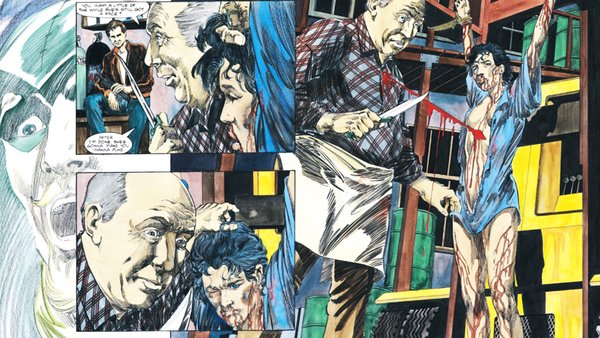Green Arrow: The Longbow Hunters (1986)
Story and Art by Mike Grell
After the titanic upheaval of CRISIS ON INFINITE EARTHS, writer/artist Mike Grell wanted Batman so badly that he got down on his knees and begged then DC Comics President Jenette Kahn for it, or so the legend goes.
Now, as fate would have it Batman was being slated for novelist Max Allan Collins, Jim Starlin, and Mike W. Barr, and so Grell was assigned to Green Arrow, a decidedly B-list character, and allowed to push him wherever his heart desired.
It's fitting that Green Arrow was his second choice, just as it is fitting that the story which followed: THE LONGBOW HUNTERS is the second wholesale makeover the character received following the legendary 1970 run of Denny O'Neil and Neal Adams on GREEN LANTERN/GREEN ARROW. A character who had been conceptualized as a pale imitation of The Batman had previously been the recipient of the skill and craft of the team that reintroduced Batman in the Bronze Age and now a first-rate talent had "fallen" to him after missing out on Batman and allowed to reshape him wholesale.
So what makes THE LONGBOW HUNTERS so great?
It's not just that it's a darker, grittier, take on a classic character. That was still novel in 1986, but if that were all that recommended the story it would be best consigned to the dustbin of history in 2024, where we stand submerged beneath an ocean of darker, grittier, re imaginings. What THE LONGBOW HUNTERS has that so few of the stories it inspired can claim is the skill, nuance, attention to detail, and artistic commitment of Mike Grell to maintain and enhance Oliver Queen's essential humanity even as he's pulling him into new and deeper darkness in his soul.
THE LONGBOW HUNTERS finds Oliver Queen at a turning point in his life: he alternates between self-deprecation and longing when talking about his previous costumed adventures; he's living with the love of his life, but she refuses to marry him while they still risk their lives; he's trapped in place by the one thing he's best at: Hunting criminals. Ollie and Dinah have come to Seattle to start a new life but soon Ollie is on the trail of serial killers and spies and Dinah is working a lead on a cocaine smuggling syndicate and by the miniseries' end nothing is the same as it was.
Every story beat is grounded in real human emotion: Ollie's transformation from a Robin Hood with boxing glove arrows to a hooded urban hunter comes from a clear and legible psychological grounding: he chides himself in the story's opening for having lost sight of who he is, and as if by magic summons a woman who is OD'ing crashes through the window to his shop. The message is clear: the "real world" has forced itself upon Green Arrow, and he must change to deal with the implications. He's gotten exactly what he longed for, but in a way he never would have asked for.
The plot of the miniseries requires a second reading to make sense of as it switches between serial killers, revenge murders, and drug trafficking spies on the turn of a dime but what makes it all work even if you're having trouble following it is how everything both feels real and seems to allude to a whole new world Ollie has entered into.
The story introduces Shado, a Japanese woman trained from birth to be a living weapon with a bow and arrow and her presence makes the story feel dangerous: she's a stone cold killer, albeit one with sympathetic motives and she is irresistible to Ollie for both her technique and for her total acceptance of purpose which counterpoints the inherent contradictions in the life Ollie has chosen as a man who fires arrows at people...whom he doesn't intend to kill. It's little wonder that she turns out to be an even better archer than our hero as she arrives fully formed in the midst of his transformation.
It's this psychological and professional vulnerability that informs the most infamous moment of the miniseries: Oliver finds out Dinah has been captured by the traffickers she's investigating and happens upon her being tortured and so in a moment of rage and shock he takes the life of the man torturing her.
This moment has been lumped in with so many other gratuitous violent moments towards female super heroes, and has been labelled "fridging" because its primary purpose is to inform the audience as to Green Arrow's new outlook but it is neither gratuitous nor sexist. It is the necessary final step to establish the stakes of not only THE LONGBOW HUNTERS but all the stories that will follow it. Green Arrow and Black Canary have crossed over from costumed villainy into the world of killers-- and they're vulnerable in ways they never have been before. The stakes have been raised.



